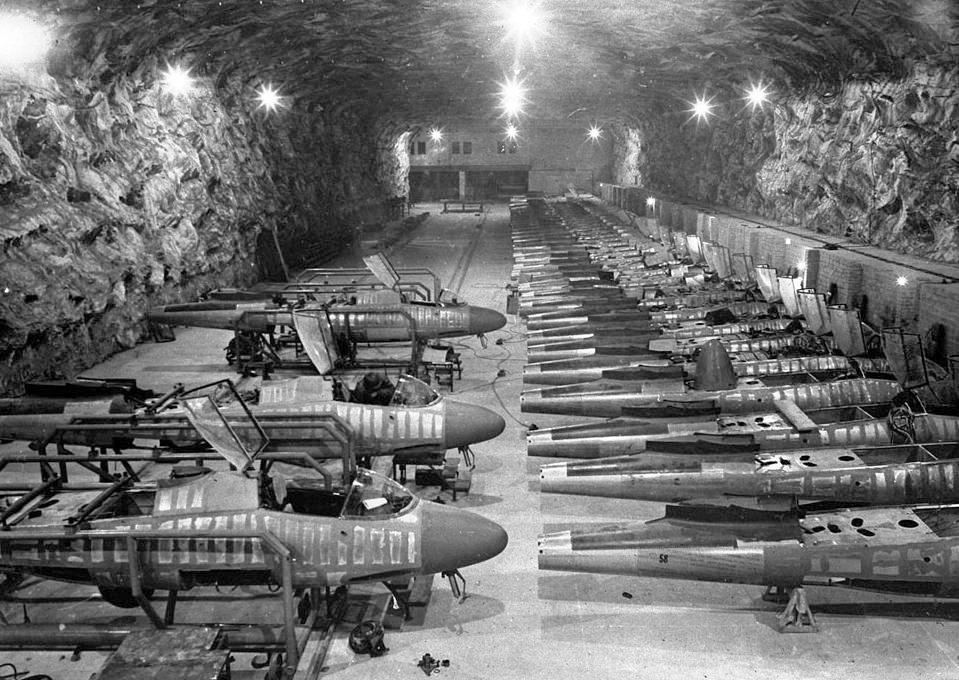
Allied Strategic Bombing Campaign: German Underground Production Plants

Figure 1.-- One of the projects taken underground by the Germans was the construction of jet aircraft. The Luftwaffe introduced the Me-262 in 1944, but Hitler interered with its appropriate usage. In the pipeline were several advanced aircraft which solved many of the problems associted with the Me-262. Here is what the Allies found when they crossed the Rhine and smashed into the Reich. It is one of the underground plants for the new second generation jets. This underground facility was located in Hinterbrühl, Austria and produced 40-50 He-162s per month. The He-162 was a fast agile, single engine fighter. If these new jets had been available only a year earlier, the Allies would have lost air superiority making the D-Day landings impossible.
|
|
The second adjustment to the Allied strategic bombing campaign was to go underground. This began in 1942 when RAF Bomber Command got the Avro Lancaster and began the strategic boming campaign in earest. Reich Marshal Göring was the Luftwaffe Commander and had pledged the German people that enemy bombers would never bomb German cities. And for the first year of the War that was largely the case. NAZI officaldom and the Geman people got in the habit of thinking that bombing was something that Germany did to other countries and not the reverse. This changed in 1942. The British began doing real damage to German war industries. Then in 1943, the NAZI regime was shocked when Bomber Command not only hit industrial cities, but one of the most secret, highest priority targets in the Reich--the missle reserach center at Peenemunde (August 1943). This convinced the German military to take its most high priority project undrground--such as the V-2 missle project. The V-1 and jet aircraft plants were aslso moved underground. This was a very difficult undertaking carving out underground tunnels. Some underground facilities existed and just needed to be expanded, such as the gypsum mines at Kohnstein. The mining process created tunnels that were converted into assembly lines. This was 3 km from Nordhausen and the NAZI slave labor camp there. Underground works were only possible for high priority weapons, like the V-weapons, on which Hitler and Goebbels set such high hopes. But again there was the insovable problem of transport. Underground production did not solve the transport problem. The components and supplies had to be delivered to the underground plants. And then the completed weapons had to be delivered to the military. This could only be done by the vulnerable rail system. Shifting production sites also delayed production and thus the introiduction of these systems. Just what that delay was we are not sure, but if these weapons had been available a year earlier, especially the second generation of jets, D-Day would not have been ppossible
CIH -- WW II

Navigate the CIH World War II Section:
[Return to Main World War II Allied European strategic bombing campaign page]
[Return to Main World War II German jet page ]
[Return to Main World War II air campaign war essay page]
[Return to Main World War II page]
[About Us]
[Biographies]
[Campaigns]
[Children]
[Countries]
[Deciding factors]
[Diplomacy]
[Geo-political crisis]
[Economics]
[Home front]
[Intelligence]
[POWs]
[Resistance]
[Race]
[Refugees]
[Technology]
[Totalitarian powers]
[Bibliographies]
[Contributions]
[FAQs]
[Images]
[Links]
[Registration]
[Tools]
[Return to Main World War II page]
[Return to Main war essay page]
[Return to CIH Home page]
Created: 5:43 PM 10/21/2016
Last updated: 5:43 PM 10/21/2016



